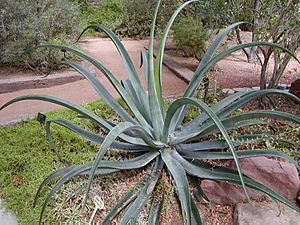Agave vilmoriniana facts for kids
Quick facts for kids Agave vilmoriniana(Octopus agave) |
|
|---|---|
 |
|
| Grown as an ornamental plant. | |
| Conservation status | |
| Scientific classification | |
| Synonyms | |
|
The octopus agave (scientific name: Agave vilmoriniana) is a special plant. It is a type of agave that grows only in México. People call it "octopus agave" because its leaves are long and twisty. They look a bit like octopus arms! These leaves are also smooth, without any sharp teeth.
Contents
About the Octopus Agave
Discovering the Octopus Agave
The first wild octopus agave plants were found in 1899. A person named Joseph Nelson Rose discovered them near Guadalajara, Jalisco, in Mexico.
Later, in 1913, a scientist named Alwin Berger officially named this plant. He named it Agave vilmoriniana to honor Maurice de Vilmorin. This name came from plants collected by Leon Diguet. These plants were grown in the Jardin des Plantes in Paris.
Where Octopus Agave Grows
In nature, the octopus agave likes to grow on cliffs. You can find it in areas called barrancas (deep canyons). These plants grow in southern Sonora, Chihuahua, Sinaloa, Jalisco, Durango, Nayarit, and Aguascalientes. They usually live in places that are 600 to 1,700 meters high.
How People Use Octopus Agave
The leaves of the octopus agave are very useful. They have a lot of a special substance called sapogenin (specifically, smilagenin). In some parts of Mexico, people cut and dry the leaves. Then, they beat the fibers to make them into a brush. This brush can even have soap built right into it!
The "octopus agave" is also grown as an ornamental plant. This means people plant it in their gardens or in pots. It is especially popular in dry gardens because it does not need much water.
See also
 In Spanish: Agave vilmoriniana para niños
In Spanish: Agave vilmoriniana para niños
- Endemic flora of Mexico



